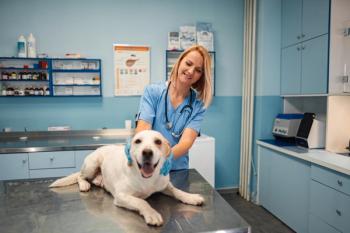
Collagen Demonstrates Prognostic Potential for Canine Breast Cancer
Collagen fibers can predict survival outcome in female dogs with mammary carcinoma.
According to a recent
Breast cancer is the top-diagnosed cancer in women and intact female dogs worldwide, making it a focus of a One Health initiative to improve human and veterinary lives. For canine breast cancer, tumor grade and stage are commonly used prognostic indicators; however, they are not accurate in all canine breast cancer cases.
Without additional prognostic indicators, the investigators cautioned, canine breast cancer treatment runs the risk of being either excessive or inadequate in some cases.
Previous studies have reported that collagen regulates breast cancer’s biologic behavior, and that tumor-associated collagen signatures (TACS) can predict recurrence. Collagen’s importance in the tumor microenvironment suggests the therapeutic potential of targeting the tumor stroma; such therapy could be useful in both human and veterinary medicine, given the similarities between human and canine breast cancer.
Experimental Design
Investigators examined 34 canine mammary gland carcinoma biopsies from the University of Pennsylvania School of Veterinary Medicine and Norwegian University of Life Sciences. The following histopathologic and clinical parameters were determined:
- Tumor stage (1—5)
- Tumor grade (I, II, III)
- Overall survival (OS; date of diagnosis date to date of death from any cause)
To evaluate collagen, investigators used second harmonic generation (SHG) imaging, which provides detailed information on collagen structure and organization. Images comprised tumor cells and stromal collagen within the tumor mass and were examined for the following characteristics:
- TACS
- Collagen density
- Collagen fiber width, length, and straightness
- Presence or absence of tumor-stromal boundary
Investigators then determined whether these collagen characteristics were associated with survival.
Results
Clinical Outcome
Several histopathologic and clinical parameters were identified as significant predictors of clinical outcome. Survival was significantly worse for:
- Stage 3/4 versus 1/2
- Grade III versus grade I/II
- Lymphovascular invasion
- Incomplete versus complete primary tumor surgical excision
- Ovariohysterectomy before excision or not at all versus at excision
Collagen
Collagen Density
Collagen density was greater in grade III than grade I/II tumors. Survival was significantly worse with high collagen density than with low collagen density (median OS, 133 vs 553 days).
Other Collagen Features
Increased collagen fiber thickness, length, and straightness were associated with significantly worse survival outcome.
TACS
TACS are markers of breast cancer progression: TACS-1 (collagen deposited near tumor), TACS-2 (straightened collagen fibers parallel to tumor), and TACS-3 (bundled collagen fibers perpendicular to tumor). Previous studies have reported an association between collagen alignment and clinical outcome for human breast cancer. In the current study, median OS didn’t significantly differ between the TACS. Also, investigators found no association between TACS and survival.
Tumor-Stromal Boundary
The tumor-stromal boundary was markedly clearer for grade I/II tumors than for grade III tumors, as evidenced by significant differences in boundary scores between grades. Survival outcomes were significantly worse for tumors with low boundary scores than high boundary scores (median OS, 210 vs 553 days).
For the Future
The study’s findings “support the use of dogs as a translational model for tumor-stromal interactions in breast cancer,” the investigators concluded. Although future studies are needed to continue analyzing collagen’s prognostic potential, “defining tumor-permissive collagen features in the dog has important implications for a One Health approach to breast cancer.”
Dr. JoAnna Pendergrass received her Doctor of Veterinary Medicine degree from the Virginia-Maryland College of Veterinary Medicine. Following veterinary school, she completed a postdoctoral fellowship at Emory University’s Yerkes National Primate Research Center. Dr. Pendergrass is the founder and owner of
Newsletter
From exam room tips to practice management insights, get trusted veterinary news delivered straight to your inbox—subscribe to dvm360.






